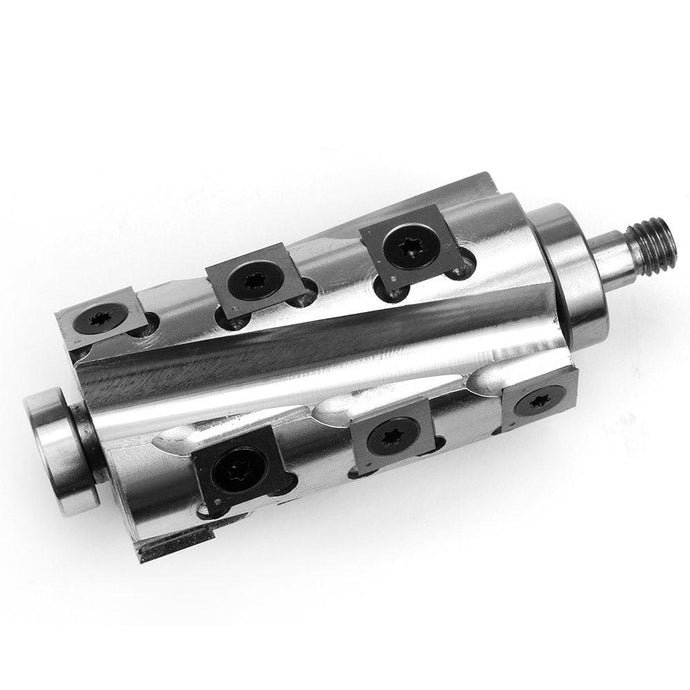- Home
- /
- Is Spiral Or Helical Better?
Is Spiral Or Helical Better?
Deciding Between Spiral and Helical: Choosing the Best Cutterhead for Your Woodworking Needs
Is Spiral Or Helical Better? This question sparks a nuanced discussion among woodworkers and craftsmen alike, delving into the subtle yet impactful differences between these two popular cutterhead designs. Understanding the unique characteristics, advantages, and applications of spiral and helical cutterheads is essential for making informed decisions that enhance woodworking precision, efficiency, and quality.
Let's begin by exploring the spiral cutterhead. Known for its continuous spiral arrangement of cutter blades along the cutterhead circumference, the spiral design offers several distinct advantages. One of its primary strengths lies in its robustness and ability to handle heavy-duty tasks with ease. The larger, continuous blades of a spiral cutterhead excel in removing material quickly and efficiently, making them ideal for planing thick hardwoods or challenging grain patterns.
Moreover, the design of the spiral cutterhead contributes to its stability and power during operation. The continuous blades provide strong, consistent cutting forces that minimize vibration and ensure smooth, uniform cuts across the width of the board. This stability is particularly advantageous for woodworking projects that require precise dimensions and a flawless surface finish.
In terms of maintenance, spiral cutterheads are relatively straightforward. While they may require occasional sharpening or adjustment, the fewer number of blades compared to traditional straight-knife cutterheads simplifies upkeep. However, it's important to note that replacing the entire row of blades in a spiral cutterhead can be more involved and costly compared to helical cutterheads, which offer modular inserts for easier replacement.
On the other hand, helical cutterheads present a different approach to woodworking precision and efficiency. Characterized by small, square or rectangular carbide inserts arranged in a spiral pattern along the cutterhead, helical designs offer several compelling advantages over traditional and spiral cutterheads alike.
One of the standout features of helical cutterheads is their ability to minimize tear-out-a common issue when planing or jointing woods with irregular grain patterns or figure. The multi-directional cutting action of the individual inserts reduces the impact on wood fibers, resulting in a smoother, tear-free surface that requires less post-processing. This makes helical cutterheads particularly favored among woodworkers who prioritize achieving a polished finish with minimal sanding.
Furthermore, the modular nature of the carbide inserts in helical cutterheads simplifies maintenance and blade replacement. Unlike spiral or traditional cutterheads where an entire row of blades may need replacing, helical cutterheads allow woodworkers to replace individual inserts as they wear or become damaged. This modularity not only reduces downtime but also extends the overall lifespan of the cutterhead, offering long-term cost savings.
Precision is another area where helical cutterheads shine. The spiral arrangement of the carbide inserts ensures uniform cutting across the width of the board, regardless of grain direction or wood density. This consistency translates into accurately planed surfaces and squared edges-a critical requirement for high-precision woodworking projects where accuracy is paramount.
Noise reduction is also a notable advantage of helical cutterheads. The design of the inserts and their multi-directional cutting action contribute to quieter operation compared to traditional straight-knife cutterheads. This quieter operation enhances the comfort of woodworkers and reduces noise pollution in the workshop environment-a significant consideration for those working in shared or residential spaces.
Durability is yet another strength of helical cutterheads. The carbide inserts are known for their hardness and wear resistance, ensuring prolonged cutting performance without significant degradation. This durability minimizes the frequency of blade replacements and maintenance, further enhancing the overall efficiency and cost-effectiveness of helical cutterheads in woodworking operations.
Ultimately, the choice between spiral and helical cutterheads depends on specific woodworking requirements, preferences, and budget considerations. For woodworkers tackling large-scale projects or working with dense hardwoods that demand robust cutting power and efficiency, a spiral cutterhead may offer the ideal solution. Its ability to handle heavy-duty tasks with precision and speed makes it a favorite among professionals seeking maximum performance.
Conversely, for woodworkers prioritizing surface quality, tear-out reduction, and versatility across different wood types and grain patterns, a helical cutterhead often proves superior. Its modular inserts, smooth cutting action, and quieter operation make it well-suited for achieving superior finishes and maintaining workshop efficiency over the long term.
In conclusion, while both spiral and helical cutterheads excel in enhancing woodworking capabilities, each design brings unique strengths to the table. By carefully considering factors such as cutting performance, surface finish quality, maintenance requirements, and operational preferences, woodworkers can confidently select the cutterhead that best aligns with their specific needs and woodworking goals. Whether you opt for the robust power of a spiral cutterhead or the refined precision of a helical cutterhead, your choice promises to elevate your woodworking craft to new heights of excellence and efficiency.
